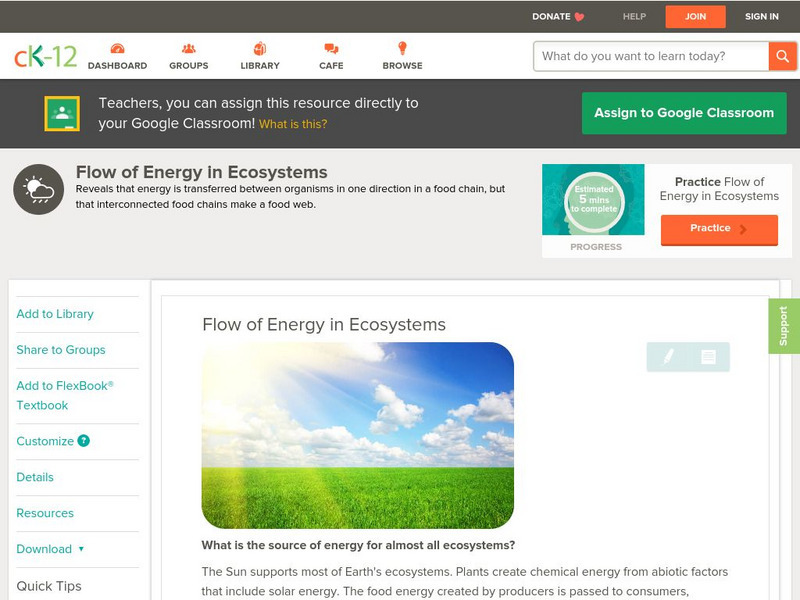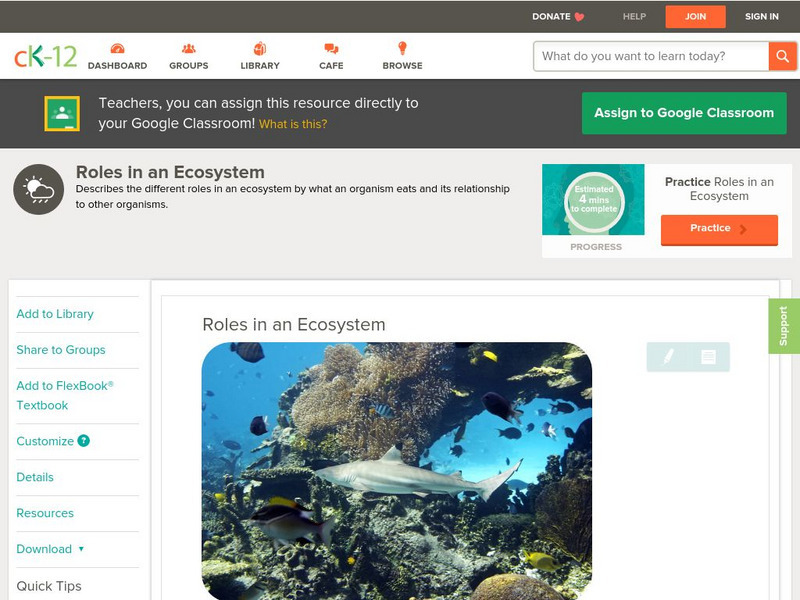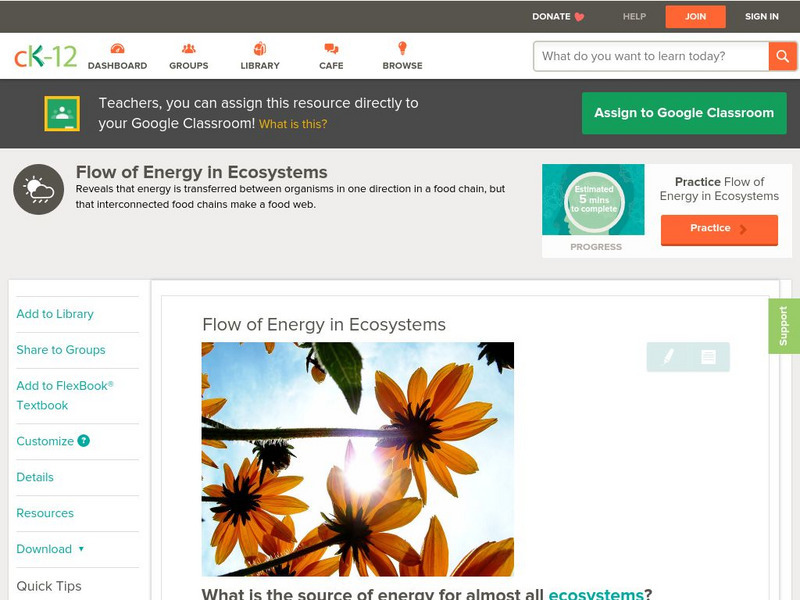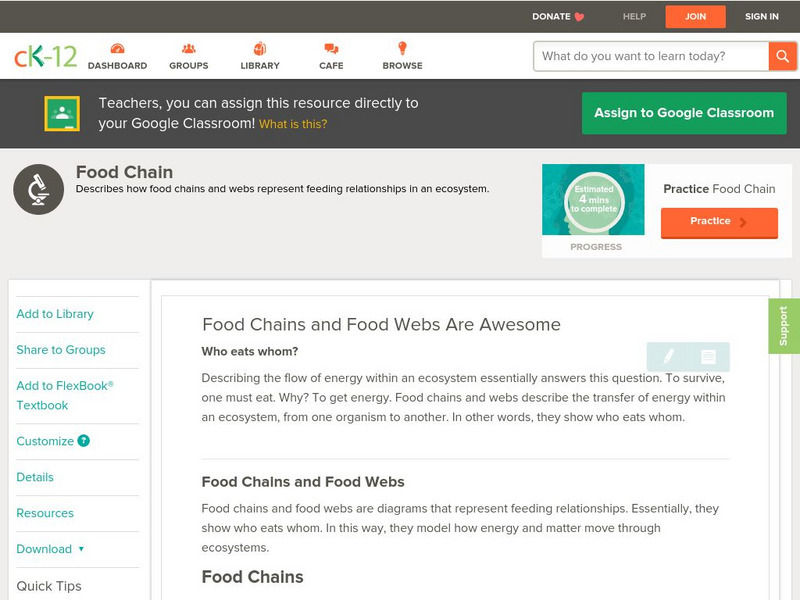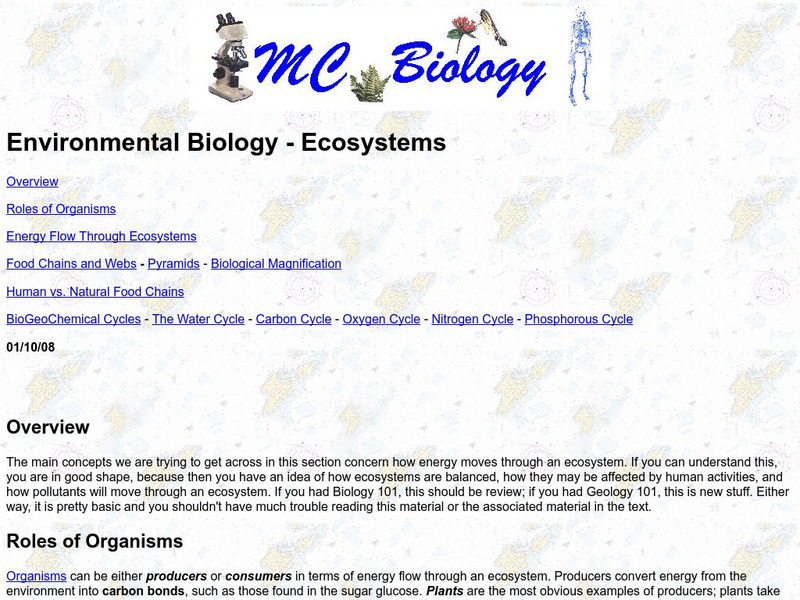Other
Digital Library for Earth System Education: Teaching Box: Seasonal Upwelling
A suite of lessons focusing on the process of upwelling. Inquiry-based exploration of seasonal upwelling includes marine food webs, food production in the ocean, wind-driven ocean currents, and seasonal changes in biotic and abiotic...
CK-12 Foundation
Ck 12: Earth Science: Flow of Energy in Ecosystems
[Free Registration/Login may be required to access all resource tools.] Describes how energy is transfered from one organism to another.
US Fish and Wildlife Service
Chlorinated Hydrocarbons (Organochlorines) Ddt
Read a brief history of the use of DDT in the United States, its effect on wildlife, and the banning of the toxin in 1972 by the EPA.
CK-12 Foundation
Ck 12: Earth Science: Roles in an Ecosystem
[Free Registration/Login may be required to access all resource tools.] Describes the different roles in an ecosystem.
CK-12 Foundation
Ck 12: Earth Science: Roles in an Ecosystem
[Free Registration/Login may be required to access all resource tools.] Describes the different roles in an ecosystem.
CK-12 Foundation
Ck 12: Biology: Autotrophs and Heterotrophs
[Free Registration/Login may be required to access all resource tools.] Discusses how autotrophs and heterotrophs obtain energy.
CK-12 Foundation
Ck 12: Biology: Mammal Structure and Function
[Free Registration/Login may be required to access all resource tools.] Describes the function of various structures in mammals.
CK-12 Foundation
Ck 12: Earth Science: Hazardous Waste
[Free Registration/Login may be required to access all resource tools.] Describes various types of hazardous waste.
CK-12 Foundation
Ck 12: Earth Science: Flow of Energy in Ecosystems
[Free Registration/Login may be required to access all resource tools.] Describes how energy is transferred from one organism to another.
Other
Segfl: Sebastian Swan: Pond Web
This interactive ebook "Pond Web" demonstrates a pond food chain. Students can click on the ? to find answers to questions posed in the text. Students are asked to retell the story using pictures provided at the end of the book.
Defenders of Wildlife
Kids' Planet: The Web of Life
The Web of Life is a story told by a common garden spider at this site from Kids' Planet. Learn about the food web, and the roles and relationships of every living creature.
OpenSciEd
Open Sci Ed: 7.4 Matter Cycling & Photosynthesis
This unit on matter cycling and photosynthesis has students investigating the idea that all food comes from plants.
CK-12 Foundation
Ck 12: Biology: Food Chains and Food Webs
[Free Registration/Login may be required to access all resource tools.] Describes how food chains and webs represent feeding relationships.
Science Struck
Science Struck: A Bird's Eye View of the Desert Food Chain
Describes how a food chain works in a desert and how the Mojave desert food chain works in particular.
Science Struck
Science Struck: Food Chain in the Tundra Region
Describes the characteristics of a tundra biome, how a tundra food chain compares to a tropical food chain, and what the different trophic levels look like.
Sophia Learning
Sophia: The Role of Plants in the Food Chain: Lesson 2
This lesson explains the role plants play in the conversion of inorganic materials into organic material to support living things. It is 2 of 3 in the series titled "The Role of Plants in the Food Chain."
Sophia Learning
Sophia: The Role of Plants in the Food Chain: Lesson 3
This lesson explains the role plants play in the conversion of inorganic materials into organic material to support living things. It is 3 of 3 in the series titled "The Role of Plants in the Food Chain."
Science Struck
Science Struck: Examples of Primary Consumers in the Food Chain
Explains what a primary consumer's role in a food chain is and provides examples.
Science Struck
Science Struck: Tropical Rainforest Food Web
Explains what a food web is, the complexity of one in a rainforest, and how energy flows through a food web.
Sophia Learning
Sophia: Food Webs
A short lesson explaining the "web of interactions" that occur in a food web. Understand how the energy flows between autotrophs and consumers. [0:35]
Science Struck
Science Struck: Rainforest Food Web
Explains the characteristics of tropical and temperate rainforests and what rainforest food webs look like.
Texas Education Agency
Texas Gateway: Energy and Matter in Ecosystems
Learners analyze food chains, webs, and pyramids to determine how energy flows and matter cycles through ecosystems.
Other
Marietta College: Biology: Energy Flow Through the Ecosystem
Read to understand how energy and inorganic nutrients flow through a food chain in an ecosystem.
Other popular searches
- Food Webs and Chains
- Ecology Food Webs Chains
- Food Webs and Food Chains
- Ocean Food Chains and Webs
- Food Webs Chains
- Food Webs Food Chains
- Food Webs, Food Chain



